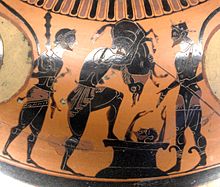Erymanthian boar
 Heracles,Eurystheusand the Erymanthian boar. Side A from anAncient Greekblack-figuredamphora,painted by theAntimenes painter,ca. 525 BC, fromEtruria.LouvreMuseum, Paris. | |
| Grouping | Legendary creature |
|---|---|
| Folklore | Greek mythology |
| Country | Greece |
| Habitat | Mount Erymanthos |
InGreek mythology,theErymanthian boar(Greek:ὁ Ἐρυμάνθιος κάπρος;Latin:aper Erymanthius) was a mythical creature that took the form of a "shaggy and wild"[1]"tameless"[2]"boar"[3]"of vast weight"[4]"and foaming jaws".[2]It was aTegeaean,[4]Maenalusian[1]orErymanthian[3]boar that lived in the "glens ofLampeia"[5]beside the "vast marsh of Erymanthus".[5]It would sally[6]from the "thick-wooded",[1]"cypress-bearing"[4]"heights of Erymanthus"[1]to "harry the groves ofArcady"[1]and "abuse the land ofPsophis".[6]
Mythology
[edit]The fourthlabour of Heracleswas to bring the Erymanthian boar alive toEurystheusinMycenae.[5]To capture the boar, Heracles first "chased the boar with shouts"[6]and thereby routed it from a "certain thicket"[6]and then "drove the exhausted animal into deep snow."[6]He then "trapped it",[6]bound it in chains,[5]and lifted it, still "breathing from the dust",[7]and returning with the boar on "his left shoulder",[7]"staining his back with blood from the stricken wound",[7]he cast it down in the "entrance to the assembly of the Mycenaeans",[5]thus completing his fourth labour. "When the king [Eurystheus] saw him carrying the boar on his shoulders, he was terrified and hid himself in a bronze vessel."[8]
"The inhabitants ofCumae,in the land of theOpici,profess that the boar's tusks which are preserved in the sanctuary ofApolloat Cumae are the tusks of the Erymanthian boar, but the assertion is without a shred of probability. "[9]
In the primitive highlands ofArcadia,where old practices lingered, the Erymanthian boar was a giant fear-inspiring creature of the wilds that lived onMount Erymanthos,a mountain that was apparently once sacred to theMistress of the Animals,for in classical times it remained the haunt ofArtemis(Homer,Odyssey,VI.105). A boar was a dangerous animal: "When the goddess turned a wrathful countenance upon a country, as in the story ofMeleager,she would send a raging boar, which laid waste the farmers' fields. "[10]

Cultural depictions
[edit]Chronological listing of classical literature sources for the Erymanthian boar:
- Sophocles,Trachiniae1097 (trans. Jebb) (Greek tragedy C5th BC)
- Apollonius Rhodius,Argonautica1. 67-111 (trans. Coleridge) (Greek epic poetry C3rd BC)
- Callimachus,Epigrams36 (trans. Mair) (Greek poetry C3rd BC)
- Diodorus of Sicily,Library of History4. 12. 1-2 (trans. Oldfather) (Greek history C1st BC)
- Virgil,Aeneid6. 801 ff (trans. Dewey) (Roman epic poetry C1st BC)
- Lucretius,Of The Nature of Things5. Proem 1 (trans. Leonard) (Roman philosophy C1st BC)
- Ovid,Metamorphoses9. 191 (trans. Melville) (Roman epic poetry C1st BC to C1st AD)
- Ovid,Heroides9. 87 ff (trans. Showerman) (Roman poetry C1st BC to C1st AD)
- Philippus of Thessalonica,The Twelve Labors of Hercules (The Greek Classics ed. Miller Vol 3 1909 p. 397) (Greek epigrams C1st AD)
- Seneca,Hercules Furens228 ff (trans. Miller) (Roman tragedy C1st AD)
- Seneca,Hercules Oetaeus17-30 (trans. Miller)
- Statius,Thebaid4. 297 ff (trans. Mozley) (Roman epic poetry C1st AD)
- Statius,Thebaid8. 746 ff
- Plutarch,Moralia,On the Fortune of Alexander 341. 11 ff (trans. Babbitt) (Greek philosophy C1st AD to C2nd AD)
- Pseudo-Apollodorus,The Library 2. 5. 3-4 (trans. Frazer) (Greek mythography C2nd AD)
- Pseudo-Hyginus,Fabulae30 (trans. Grant) (Roman mythography C2nd AD)
- Pausanias,Description of Greece8 24. 5-6 (trans. Frazer) (Greek travelogue C2nd AD)
- Quintus Smyrnaeus,Fall of Troy6. 220 ff (trans. Way) (Greek epic poetry C4th AD)
- Nonnus,Dionysiaca25. 194 (trans. Rouse) (Greek epic poetry C5th AD)
- Nonnos,Dionysiaca25. 242 ff (trans. Rouse) (Greek epic poetry C5th AD)
- Boethius,The Consolation of Philosophy4. 7. 13 ff (trans. Rand & Stewart) (Roman philosophy C6th AD)
- Suidas s.v.Dryopes(trans. Suda On Line) (Byzantine Greek Lexicon C10th AD)
- Tzetzes,ChiliadesorBook of Histories2. 268 ff (trans. Untila et al.) (Byzantinian history C12 AD)
- Tzetzes,ChiliadesorBook of Histories2. 494 ff
See also
[edit]References
[edit]- ^abcde"Hercules Furens 228 ff.".Seneca's Tragedies.Vol. 1. Translated by Miller, Frank Justus. London; New York: William Heinemann; G. R Putnam's Sons. 1917. p. 21. ark:/13960/t71v5s15x.
- ^ab"The Fall of Troy, Book VI. 220 ff.".Quintus Smyrnaeus The Fall Of Troy.Translated by Way, A. S. London; Cambridge, Massachusetts: William Heinemann Ltd; Harvard University Press. 1984 [1913]. p. 271. ark:/13960/t2m61f62d.
- ^ab"Trachiniai. 1097".Sophocles The Plays and Fragments.Vol. 5 The Trachiniae. Translated by Jebb, R. C. Cambridge: The University Press. 1892. p. 159. ark:/13960/t6tx3f955.
- ^abc"The Heroides 9. 87 ff".Ovid Heroides And Amores.Translated by Showerman, Grant. London; New York: William Heinemann; The Macmillan Co. 1914. p. 115. ark:/13960/t76t0t11q.
- ^abcde"The Argonautica. Book 1 67-111"."The Argonautica" of Apollonius Rhodius.Translated by Coleridge, Edward P. London: George Bell And Sons, York Street, Covent Garden. 1889. p. 8. ark:/13960/t03x8577n.
- ^abcdef"The Library 2. 5. 3-4".Apollodorus the Library.Vol. 1. Translated by Frazer, Sir James George. New York: G. P. Putnam's Sons. 1921. pp. 191 with the Scholiast. ark:/13960/t00012x9f.
- ^abc"Thebaid, VIII. 731-760. 746 ff.".Statius.Vol. 2. Translated by Mozley, J. H. London; New York: William Heinemann Ltd.; G. P. Putnam's Sons. 1928. p. 249. ark:/13960/t19k4m13k.
- ^"Book 4. 12. 1-2".Diodorus of Sicily.Vol. 2. Translated by Oldfather, C. H. London; Cambridge, Massachusetts: William Heinemann Ltd; Harvard University Press. 1967 [1935]. p. 381. ark:/13960/t7qn6bw6r.
- ^"Bk. VIII. Arcadia 24. 5-6".Pausanias's Description of Greece.Translated by Frazer, J. G. London; New York: Macmillan and Co. Limited; The Macmillan Company. 1898. p. 402. ark:/13960/t5t72bt15.
- ^Kerenyi (1959), p. 149.
External links
[edit]- Graves, Robert,The Greek Myths1955.
- Kerenyi, Karl,The Heroes of the Greeks1959.
- Carl A. P. Ruckand Danny Staples,The World of Classical Myth,1994.
- Ovid,Heroides
- Pseudo-Apollodorus,Bibliothecaii.5.4
- Diodorus Siculusiv.12
- Apollonius of Rhodes,Argonauticai.122ff
- Pausanias,Description of Greecei.27.9
